The ISSF History
The ISSF History Milestones
1907-2018
19th century – During the 19th century, earlier forms of organizations such as shooting clubs developed into national shooting federations. The Société Suisse des Carabiniers was founded in 1824 in Switzerland; Queen Victoria inaugurated the British National Rifle Association in 1859. Duke Ernst II of Saxony-Coburg and Gotha founded the Deutscher Schützenbund in 1861, and military leaders established the National Rifle Association of America (USA) in 1871.
The Federation Francaise des Societies de Tir was formally established in 1884, but earlier French national federations had preceded it.
1896 – The shooting sport began part of the modern Olympic Family since its first steps. In the first Olympic Games, held in Athens in 1896, 39 shooters from seven nations competed in three pistol and two highpower rifle events. Shooting also was included in the program of the second Olympic Games where 139 shooters from 13 nations competed in three pistol, five rifle, two clay target and one running target events.
1907 – On 17 July 1907, representatives of seven national shooting federations, six from Europe (Austria, Belgium, France, Greece, Italy, Holland) and one from South America (Argentina), met in in Zurich, Switzerland, to formally establish the L’Union Internationale des Fédérations et Associations nationals de Tir (International Union of National Shooting Federations and Associations) in a meeting that would be remembered as the first ISSF General Assembly.
The President of L’Union des Sociétés de Tir de France, Daniel Mérillon, a 55-year old lawyer from Paris, was elected as the first ISSF President.
1908 – The second General Assembly of the ISSF history took place in Vienna, during the International Matches. Three new member federations from England, Germany and Hungary, were also represented. The Swiss shooting federation, after the first indecisions, joined the union at the General Assembly. Later on, during the year 1908, USA would joint the union.
1909 – The shooting family grows, and more national federations join the union. Between 1909 and 1914, Serbia, Denmark, Spain, Portugal, Sweden, Peru, Mexico and Finland become members of the Union Internationale, following the desire by the first ISSF leaders to make their organization a world sports federation.
1912 – 284 shooters, coming from 16 different countries, participated in the 1912 Olympic Games of Stockholm, Sweden, in 15 total events, two pistol, eight rifle, two shotgun and three running target.
1916 – The 1st World War in Europe caused the cancellation of the 1916 Olympic Games which were to take place in Berlin, and the next ISSF International Matches which were to take place in 1916. President Mérillon circulated a written proposal to the member federations and the decision was made, by a vote of ten to six, to dissolve the Federation. L’Union des Sociétés de Tir de France was entrusted with the care of the ISSF records and property.
1920 – President Mérillon invited the national federations that were members in 1915 and federations representing new countries formed after the war to come to a meeting in Paris on 16 April 1920 to renew ISSF activities. Delegates from 14 countries attended and agreed to reestablish the ISSF under the name L’Union Internationale de Tir (UIT). Mérillon was reelected President of the Union.
1920 – The 1920 Olympics of Antwerp saw 21 shooting events in its program, the highest number of events in Olympic history. 18 nations participated with 233 athletes.
1921 – IOC – International Olympic Committee - decided in 1921 that ISSF regulations were to govern the shooting events in the 1924 Games. This was the first concrete step in forging a union between the ISSF and the IOC that was to have such a profound impact on the Federation’s future.
1924 – The shooting events of the Paris Olympiad used ISSF regulations and were organized by L’Union des Sociétés de Tir de France. Over 260 athletes from 27 nations participated in the Olympic shooting events.
1927 – After the premature death of Mérillon, his son-in-law Jean Carnot was elected as the second ISSF President in a divided vote at the General Assembly held in Rome in 1927.
1928 - A crisis in the ISSF’s relationship with the IOC occurred between the years 1926 and 1928. The practice of awarding money prizes in ISSF World Championships clashed with strict IOC amateur standards. As a result, the IOC excluded shooting from the 1928 Olympic Games in Amsterdam. At its 1928 General Assembly, ISSF delegates approved an appeal to the IOC to reinstate shooting to the 1932 Olympic Games program.
1932 - Shooting was re-included on the Olympic program of the Games of Los Angeles, but the number of the events was greatly reduced. There were only two shooting events, one rifle and one pistol. 41 athletes from 10 countries took part, but many of the world’s best marksmen were not there because their acceptance of money prizes in other competitions made them incompatible with the IOC amateur standards.
1936 - Shooting was again on the Olympic program in Berlin in 1936, this time with three events, a smallbore rifle 50 meter 30-shot prone event and two pistol events, the traditional 50 meter free pistol event and the new 25 meter rapid-fire pistol event that had been tested at the 1933 World Championship.
1937 – The year 1937 saw the first participation of a Woman in an open World Championship event. Catherine Woodring fired as a member of the USA team, winning the 50-meter rifle prone gold team medal.
1940 – Olympic Games of Helsinki could not take place: the Second World War was exploded. For the second time in the ISSF’s short history, a decision was made to suspend operations.
The ISSF records and archives were transported by Karl August Larsson, Secretary General of the Swedish shooting federation, from Paris to Stockholm, where they could be protected in a neutral nation.
1947 – After the conclusion of the Second World War, eight member federations agreed on holding a World Championship and a General Assembly in Stockholm in 1947. There, Erik Carlsson, President of the Swedish shooting federation was elected as the third ISSF President and Karl August Larsson as its Secretary General.
1948 – 300m Rifle event returns at the Olympic program of the 1948 Games after missing since 1924
1951 – The Pan American Games and Asian Games were both created as multi-sport international competitions like the Olympic Games, on their respective continents in 1951. Shooting was accepted as a sport in both. Pan American and Asian Games, with shooting included, have been staged every four years since 1951.
1954 – The 1954 World Championship returned to South America for the third time in ISSF history when it took place at Caracas, Venezuela. Thereafter, a four-year cycle for World Shooting Championships was adopted.
1955 – The first European Shooting Championship was held in 1955 in Bucharest, Rumania. The European Shooting Confederation was formally organized in 1958 and has continued to organize European Championships on an annual or bi-annual basis since.
1958 – Men’s Skeet event was added at the ISSF program.
1960 – At General Assembly that took place at Rome during the 1960 Olympics, President Carlsson, who had served for 14 years, decided not to be a candidate for reelection. The assembly, which was attended by delegates from a record 55 countries, elected Dr. Kurt Hasler, who was President of the Swiss shooting federation, as the fourth ISSF President.
1966 - The ISSF recognized all of its open events as “mixed” events where women could participate with men in 1966. The IOC also agreed to apply this standard to Olympic shooting events. For four Olympiads, from 1968 through 1980, the Olympic shooting events were mixed, with opportunities for women and men to participate regardless of gender.
1966 – Air Rifle event was added at the ISSF program.
1970 – Air Pistol event was added at the ISSF program.
1975 – Mr. Olegario Vazquez Raña was elected President of the Mexican Shooting Federation.
1976 – President Kurt Hasler, after serving the ISSF fort 16 years, decided not to stand for reelection. The leading candidate was First Vice President George Vichos, a lawyer from Athens, Greece, who won an election decided by just one vote in his favor.
1978 – In 1978, the ISSF General Assembly elected several new Administrative Council members including Olegario Vazquez Raña, President of the Mexican Shooting Federation.
1979 – Olegario Vazquez Raña was elected as President of the Confederación Americana de Tiro (CAT).
1980 – During the ISSF General Assembly of the XXII Olympiad that was held at Mexico City in 1980, Olegario Vazquez Raña emerged as the leading candidate to be the next ISSF President. Vazquez Raña was an active, successful shooter who competed for Mexico in four Olympic Games (1964, 1968, 1972, 1976) and five World Shooting Championships (1966, 1970, 1974, 1978, 1979).
When the day to elect a new ISSF President came in February 1980, Olegario Vazquez Raña was elected as the sixth ISSF President with 125 of the 132 votes present at the Assembly.
The 1980 General Assembly also elected a new Secretary General, Mr. Horst G. Schreiber, a prominent attorney in Munich, Germany who had successfully served in leadershop roles in the sports of shooting, golf and tennis.
1980 – Being a worldwide organization with member federations in over 100 countries was changing the needings of the ISSF. The new leadership promoted a new ISSF Constitution, that was drafted and approved by an Extraordinary General Assembly that met in Moscow in 1980. The new Constitution transferred technical rule making authority to the Administrative Council and increased the authority of ISSF Section Committees and strengthened the Federation’s financial accountability.
1980 – The General Assembly established the ISSF Women’s Committee that took the place of the 1977’s provisional Ladies Committee.
1984 – Ms. Unni Nicolaysen, the Secretary General of the Norwegian shooting federation, became the first woman in the 77-year history of the Federation to be elected to membership on the Administrative Council, a body with real decision-making power.
1984 - The IOC agreed to add three women’s events, 10 meter air rifle, 50 meter small-bore rifle 3x20, and 25 meter sport pistol, to the 1984 Olympic Games program.
1986 – Following the invitation of the IOC, the ISSF develop an Olympic qualification system.
The ISSF established a new series of World Cups, included them in the Olympic qualifying system, and recognize scores fired in World Cups as World Records. The first ISSF World Cup Rifle and Pistol was held in Mexico City, Mexico in March 1986 followed by the first ISSF World Cup Shotgun set in Montecatini, Italy, in April 1986.
1987 –Starting from that year, an annual World Cup Final where the shooters with the best scores in that year’s ISSF World Cups were invited to compete in a “champion-of-champions” competition at the end of each year and it became a new fixture on the ISSF Championship calendar.
1988 – The 10 meter Air Pistol Women Event was added to the 1988 Olympic program of the Seoul Games.
1993 – The ISSF established the Training Academy in 1993. By conducting regular courses in several locations, the ISSF Academy has now trained over 400 shooting coaches from 74 different national federations.
1994 – The ISSF General Regulations recognize 15 junior men’s events and 10 junior women’s events that were added to the program of the ISSF World Championships.
1996 – A shotgun event, double trap women, was added to the 1996 Olympic Games program.
1998 – At the 1998 General Assembly in Barcelona, the word “sport” was formally incorporated into the ISSF’s modern name, “International Shooting Sport Federation.”
2000 – Following the introduction of the double trap women event at the previous Games of Atlanta, two additional women’s shotgun events, trap and skeet, were added to the program of Sydney 2000.
2004 – The Olympic Games of Athens saw a record participation of 106 countries, presenting 390 shooters to compete in 17 events.
2004 – After the 2004 Olympics, women’s double trap and 10 meters running target were deleted when the overall Olympic shooting program was reduced from 17 to 15 events.
2006 - The most recent World Championship in Zagreb, Croatia in 2006, saw a record of participations: 1932 athletes from 97 countries were hosted in Zagreb. With the junior events, there were 54 individual and 51 team events.
2006 – The 2006 ISSF General Assembly voted and reelected President Olegario Vazquez Raña and Secretary General Horst G. Schreiber.
2007 – Twenty years after the foundation of the ISSF World Cup series, at the 2007 Munich World Cup Rifle and Pistol 834 athletes from 81 countries participated.
2007 – One century after that first meeting in Zurich, the 17th of July 2007, ISSF celebrated his 100 years anniversary. The Federation now has 158 national federation members in 146 countries on all five continents. The ISSF began as a governing body for only two target shooting events, one rifle and one pistol. Today it has become the world governing body for four shooting disciplines, pistol, rifle, running target and shotgun that include 15 Olympic and 23 World Championship events. During 100 years of activity, a small organization with very humble beginnings has grown to govern an Olympic sport that is one of the largest and most popular in the world.
2008 – The Olympic Games of Beijing saw the participation of 103 countries, presenting 390 shooters to compete in 15 events (9 men and 6 women), in the disciplines of Rifle, Pistol and Shotgun. Following what the IOC President Jacques Rogge called "a tradition", the first Gold medal of the XXIX Olympiad was assigned to the Shooting sport. On August the 9th, Czech's Katerina Emmons became the first Olympic Gold medallist of the Olympic Games of Beijing 2008 by winning the 10m Air Rifle Women event.
2012 - 390 athletes coming from 108 nations competed in 15 Olympic Shooting events (9 men and 6 women), in the disciplines of Rifle, Pistol and Shotgun, at the XXX Olympic Games in London. The competitions were held at the Royal Artillery Barracks
2013 - Following the London Games, the ISSF introduces major changes to its rules. Olympic Shooting events' finals will from now on start from zero: the qualification score is not carried forward into the Finals anymore. Shotgun events see the introduction of semi-finals and medal matches. Rifle and Pistol Finals are now conducted elimination-style
2014 - Over 2000 athletes adding up to almost 4000 starts, 14 days of competitions, 53 events conducted, 64 Olympic quota places assigned, more than 300 medals awarded: these are the impressive numbers of the 51st ISSF World Championship in all Shooting events, held at the CEAR Juan Carlos I shooting range of Las Gabias, Granada, Spain, form the 6th through the 20th of September.
The ISSF General Assembly - meeting in Munich (GER) on the 2nd and 3rd of December 2014 - re-elected Mr. Olegario Vazquez Raña (MEX) as ISSF President for his ninth consecutive Presidential term since the first election in 1980. Mr. Franz Schreiber (GER) was elected as the new ISSF Secretary General by unanimous decision of the Assembly.
2015 - The qualifications for the 2016 Olympic Games in Rio de Janeiro - which started at the 2014 ISSF World Championship in Granada - continue. The ISSF World Cup Series, the ISSF Shotgun World Championship in Lonato, and selected Continental Championships distribute quota places for Rio 2016 to the best shooters of the world.
2016 - 390 athletes from 97 nations qualify to compete in 15 Rifle, Pistol and Shotgun events at the Rio 2016 Olympic Games from the 6th throguh the 14th of August 2016
2017 - The first ISSF Target Sprint World Championship takes place in Suhl (GER) from June 22nd to June 26th.
An Extraordinary General Assembly is held in Munich (GER) on June 25th: 137 member federations attended the assembly. The Olympic Programme for the Tokyo 2020 Olympic Games is approved by the EGA.
Some weeks laters, the ISSF Shotgun World Championship is held at the Fox Lodge Shooting Range in Moscow (RUS), starting on August 30th and concluding on September 11th. The competition sees the participation of 640 shooters from 76 nations, who competed in 22 medal events. The first world titles in the Trap Mixed Team event is awarded to Australia.
2018 - The ISSF World Cup program reaches perfect gender equality balance with six men events, six women events and three mixed team events. The ISSF World Cup Series adds indeed three mixed team events to its program: 10m Air Rifle Mixed Team, 10m Air Pistol Mixed Team, Trap Mixed Team. In a further step to ensure gender equality, men and women now shoot the same number of targets.
The 52nd ISSF World Championship in all events is held in Changwon (KOR) from August 31st to September 15th, also serving as the first competition with Olympic quota places for Tokyo 2020 up for grabs.
On November 30th the 68th ISSF General Assembly elects Vladimir Lisin (RUS) as the 7th ISSF President. Alexander Ratner(RUS) is elected as the new ISSF Secretary General.
On December 1st, the ISSF General Assembly elects Luciano ROSSI (ITA) as the 8th ISSF President. Willi GRILL (GER) is elected as the new ISSF Secretary General.
On the February 19th 2024 Alessandro NICOTRA DI SAN GIACOMO was unanimous elected as the new ISSF Secretary General.
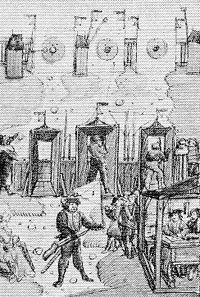
16th Century painting
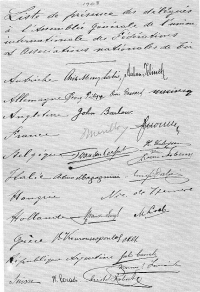
Attendance List of signatures for the General Assembly, June 1908, Vienna
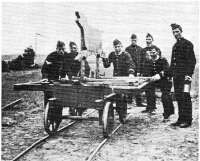
Running Deer shooting at Wimbledon in England in 1862
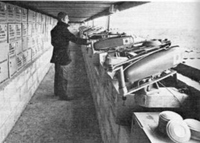
“Modern” shotgun installation from the late 50’s
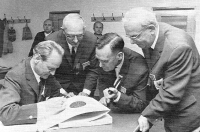
Results Jury re-examining targets of the World Championsships in 1966